Louisiana town the canary in the coalmine as climate effects worsen

Last week, one south-west Louisiana city in particular was girding itself for Hurricane Francine’s blow: Lake Charles, located about four hours west of New Orleans and two hours east of Houston.
In the lottery of hurricane paths over the past 20 years, Lake Charles has been very, very unlucky. But Francine’s impact on the city turned out to be relatively minor, a summer storm like locals are used to.
But had the hurricane shifted a bit west, it could have collided with a place still recovering from the last storms – a place literally sorting through the rubble of its emblem glorifying the town’s oil- and gas-driven economy.
The city’s only skyscraper, the Capital One Tower, symbolizes Lake Charles’s unfortunate fate as a city that has embraced Louisiana’s oil and gas industry even as the climate crisis it causes increasingly wreaks havoc on it.
The 310ft metal-and-glass structure has been Lake Charles’s most famous building since its opening in 1983, and the postcard image representing Lake Charles’s power in the oil and gas industry, dwarfing everything else in town.
According to the US Energy Information Administration, today Louisiana provides 10% of the country’s marketed natural gas production and 61% of the US’s natural gas exports. Lake Charles is the biggest contributor to those numbers, with a disproportionate number of refineries and facilities around the city’s edges.
Through oil busts and booms, the tower stood like a beacon for the town’s success in the energy industry, a bulwark against climate change’s doomsayers even as the climate has warmed and the hurricanes barrelling in from the Gulf have got stronger.
In the 1980s, the members-only City Club was the ritzy restaurant on the tower’s top floor where energy executives tippled martinis and sliced into filets during lunch. Rhonda Kleckley, the owner of Accessory Zone, a popular store in town, recalls joining her husband, who worked in the tower, for fancy dinners at the City Club. “For years and years it was the place to be,” she said.
In fact, it was Lake Charles’s version of Windows on the World, the restaurant on the top floor of New York’s World Trade Center, except instead of offering views across the rooftops of Manhattan, the City Club’s windows looked out on to an endless horizon of oil refineries and petrochemical smokestacks.
Through the energy market’s good times and bad times, the tower stood mighty, its blue-hued “hurricane-proof” glass reflecting the water that gave the town its name.
More recently, the building’s hurricane-proofing once touted by the developer has come into question. Lake Charles was hit by Hurricane Rita in 2005, and the tower was flooded so badly it was closed for nearly two years.
But it was in the doldrums of the pandemic that locals started to feel like there was a meteorological target on their back, as the city suffered a one-two punch from two huge hurricanes, six weeks apart.
On 27 August 2020, Hurricane Laura, the 10th-strongest US hurricane on record, made landfall near Lake Charles. The category 4 storm’s 150mph (240km/h) winds smashed through the hurricane-proof glass, leaving open wounds on all sides of the building. Over the following weeks, the hollowed-out windows were boarded up with plywood.
As the city struggled to recover from Laura, another storm formed in the warm waters of the Gulf, and wary residents watched as the weather forecasters sketched its trajectory right through Lake Charles, again.
Hurricane Delta – so-named because there were so many storms that season that the whole English alphabet had been run through, and the Greek alphabet started being used – made landfall on 9 October, again just south of Lake Charles. The 100mph winds of Delta were strong enough to blast through the plywood bracing the tower’s offices from the elements. The building was left looking like an apocalyptic checkerboard, its remaining panes of blue glass interspersed by broken plywood.
But now the tower is gone.
At 8am on 7 September, after years of legal wrangling about what to do with the beat-up structure, the tower was imploded. In a matter of seconds, Lake Charles was marked by a cloud of dust that settled over a place that looked now more like a town rather than a city.
“We wanted nothing more than to see the tower renovated,” Lake Charles’s mayor, Nic Hunter, told local news, adding that the city had met with many developers and given the building “every possible shot of being redeveloped”. In the end, private funds were set aside from an insurance settlement with the building’s owner to finance the implosion.
“If I could go back in time and ask the architect to alter perhaps the way this building was designed with as many windows as it was, I would do that. If I could go back in time and have Hurricane Laura never hit Lake Charles, I would do that. However, we are living in the world we are living in today,” Hunter said.
That world is one where, it seems, where ever-strengthening hurricanes are making the rules.
Louisiana is on the frontlines of climate change, and the havoc in Lake Charles is a canary in the coalmine of what American cities will see before long, as storm after storm makes the architects of the past look shortsighted, and forces residents to see their city’s climate liabilities for what they are.
“There’s a lot of history there, but it needed to come down,” shop owner Kleckley said about the tower’s implosion.
Kleckley is an example of a small business owner determined to ride out the storms that hit Lake Charles. Twice has she seen her store completely destroyed by hurricanes: Rita in 2005 and Laura in 2020. “The hurricane literally came through the front door and took everything out,” she said. They lost the majority of their inventory both times.
This week, though, she said she felt calm. “I wasn’t worried about Francine at all, since a category 1 or 2 isn’t anything compared to what we’ve gone through.”
Many others in Lake Charles, though, have headed for the door. Since Laura, the city has seen some of the highest rates of climate migration of anywhere in the US as residents throw in the towel and move to higher ground outside of hurricanes’ favorite path.
Today there is a sense that the town has been forced to give up the dream of progress the tower was built upon to instead focus on hunkering and defending.
According to the city government, the cleanup from the implosion is expected to take 90 days. The rubble – a pile of potential projectiles of glass and steel – sat there as Francine came ashore to the east, the outer bands of its wind and rain dancing on the tower’s grave, a morbid reminder of who wins when industry battles climate.





